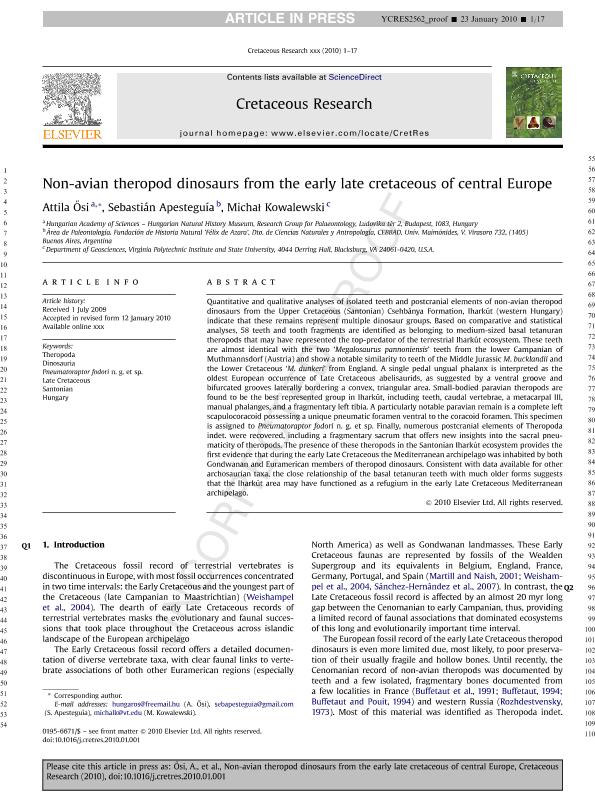Mostrar el registro sencillo del ítem
dc.contributor.author
Odouble acutesi, Attila
dc.contributor.author
Apesteguía, Sebastián

dc.contributor.author
Kowalewski, Michal
dc.date.available
2023-02-16T14:35:38Z
dc.date.issued
2010-06
dc.identifier.citation
Odouble acutesi, Attila; Apesteguía, Sebastián; Kowalewski, Michal; Non-avian theropod dinosaurs from the early late cretaceous of central Europe; Academic Press Ltd - Elsevier Science Ltd; Cretaceous Research; 31; 3; 6-2010; 304-320
dc.identifier.issn
0195-6671
dc.identifier.uri
http://hdl.handle.net/11336/188277
dc.description.abstract
Quantitative and qualitative analyses of isolated teeth and postcranial elements of non-avian theropod dinosaurs from the Upper Cretaceous (Santonian) Csehbánya Formation, Iharkút (western Hungary) indicate that these remains represent multiple dinosaur groups. Based on comparative and statistical analyses, 58 teeth and tooth fragments are identified as belonging to medium-sized basal tetanuran theropods that may have represented the top-predator of the terrestrial Iharkút ecosystem. These teeth are almost identical with the two '. Megalosaurus pannoniensis' teeth from the lower Campanian of Muthmannsdorf (Austria) and show a notable similarity to teeth of the Middle Jurassic M. bucklandii and the Lower Cretaceous '. M. dunkeri' from England. A single pedal ungual phalanx is interpreted as the oldest European occurrence of Late Cretaceous abelisaurids, as suggested by a ventral groove and bifurcated grooves laterally bordering a convex, triangular area. Small-bodied paravian theropods are found to be the best represented group in Iharkút, including teeth, caudal vertebrae, a metacarpal III, manual phalanges, and a fragmentary left tibia. A particularly notable paravian remain is a complete left scapulocoracoid possessing a unique pneumatic foramen ventral to the coracoid foramen. This specimen is assigned to Pneumatoraptor fodori n. g. et sp. Finally, numerous postcranial elements of Theropoda indet. were recovered, including a fragmentary sacrum that offers new insights into the sacral pneumaticity of theropods. The presence of these theropods in the Santonian Iharkút ecosystem provides the first evidence that during the early Late Cretaceous the Mediterranean archipelago was inhabited by both Gondwanan and Euramerican members of theropod dinosaurs. Consistent with data available for other archosaurian taxa, the close relationship of the basal tetanuran teeth with much older forms suggests that the Iharkút area may have functioned as a refugium in the early Late Cretaceous Mediterranean archipelago.
dc.format
application/pdf
dc.language.iso
eng
dc.publisher
Academic Press Ltd - Elsevier Science Ltd

dc.rights
info:eu-repo/semantics/openAccess
dc.rights.uri
https://creativecommons.org/licenses/by-nc-sa/2.5/ar/
dc.subject
Theropoda
dc.subject
Late Cretaceous
dc.subject
Santonian
dc.subject
Hungary
dc.subject.classification
Paleontología

dc.subject.classification
Ciencias de la Tierra y relacionadas con el Medio Ambiente

dc.subject.classification
CIENCIAS NATURALES Y EXACTAS

dc.title
Non-avian theropod dinosaurs from the early late cretaceous of central Europe
dc.type
info:eu-repo/semantics/article
dc.type
info:ar-repo/semantics/artículo
dc.type
info:eu-repo/semantics/publishedVersion
dc.date.updated
2023-02-16T13:45:39Z
dc.journal.volume
31
dc.journal.number
3
dc.journal.pagination
304-320
dc.journal.pais
Estados Unidos

dc.description.fil
Fil: Odouble acutesi, Attila. Hungarian Natural History Museum; Hungría
dc.description.fil
Fil: Apesteguía, Sebastián. Universidad Maimónides. Área de Investigaciones Biomédicas y Biotecnológicas. Centro de Estudios Biomédicos, Biotecnológicos, Ambientales y de Diagnóstico; Argentina. Consejo Nacional de Investigaciones Científicas y Técnicas; Argentina
dc.description.fil
Fil: Kowalewski, Michal. Virginia Polytechnic Institute and State University; Estados Unidos
dc.journal.title
Cretaceous Research

dc.relation.alternativeid
info:eu-repo/semantics/altIdentifier/url/https://www.sciencedirect.com/science/article/pii/S0195667110000029
dc.relation.alternativeid
info:eu-repo/semantics/altIdentifier/doi/http://dx.doi.org/10.1016/j.cretres.2010.01.001
Archivos asociados
